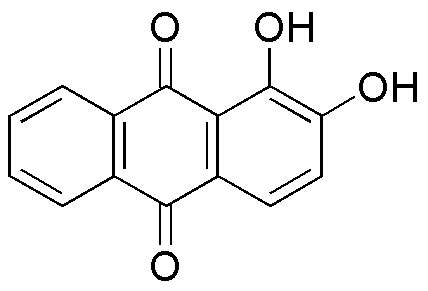Alizarin is widely utilized in research focused on:
- Dye Production: Alizarin is a natural dye used in textiles, providing vibrant colors for fabrics. Its historical significance as a dye makes it popular in the fashion and textile industries.
- Biological Staining: In histology, Alizarin is employed for staining bone and mineralized tissues, helping researchers visualize and study cellular structures under a microscope.
- Analytical Chemistry: It serves as a reagent in various analytical methods, particularly in the detection of calcium ions, which is crucial in environmental and biological studies.
- Art Conservation: Alizarin is used in the restoration of historical artworks, allowing conservators to replicate original colors without compromising the integrity of the piece.
- Pharmaceutical Research: Its properties are explored in drug development, particularly in creating compounds that can target specific biological pathways, offering potential therapeutic benefits.
General Information
Properties
Safety and Regulations
Applications
Alizarin is widely utilized in research focused on:
- Dye Production: Alizarin is a natural dye used in textiles, providing vibrant colors for fabrics. Its historical significance as a dye makes it popular in the fashion and textile industries.
- Biological Staining: In histology, Alizarin is employed for staining bone and mineralized tissues, helping researchers visualize and study cellular structures under a microscope.
- Analytical Chemistry: It serves as a reagent in various analytical methods, particularly in the detection of calcium ions, which is crucial in environmental and biological studies.
- Art Conservation: Alizarin is used in the restoration of historical artworks, allowing conservators to replicate original colors without compromising the integrity of the piece.
- Pharmaceutical Research: Its properties are explored in drug development, particularly in creating compounds that can target specific biological pathways, offering potential therapeutic benefits.
Documents
Safety Data Sheets (SDS)
The SDS provides comprehensive safety information on handling, storage, and disposal of the product.
Product Specification (PS)
The PS provides a comprehensive breakdown of the product’s properties, including chemical composition, physical state, purity, and storage requirements. It also details acceptable quality ranges and the product's intended applications.
Certificates of Analysis (COA)
Search for Certificates of Analysis (COA) by entering the products Lot Number. Lot and Batch Numbers can be found on a product’s label following the words ‘Lot’ or ‘Batch’.
Numéro de catalogue
Numéro de lot/série
Certificates Of Origin (COO)
This COO confirms the country where the product was manufactured, and also details the materials and components used in it and whether it is derived from natural, synthetic, or other specific sources. This certificate may be required for customs, trade, and regulatory compliance.
Numéro de catalogue
Numéro de lot/série
Safety Data Sheets (SDS)
The SDS provides comprehensive safety information on handling, storage, and disposal of the product.
DownloadProduct Specification (PS)
The PS provides a comprehensive breakdown of the product’s properties, including chemical composition, physical state, purity, and storage requirements. It also details acceptable quality ranges and the product's intended applications.
DownloadCertificates of Analysis (COA)
Search for Certificates of Analysis (COA) by entering the products Lot Number. Lot and Batch Numbers can be found on a product’s label following the words ‘Lot’ or ‘Batch’.
Numéro de catalogue
Numéro de lot/série
Certificates Of Origin (COO)
This COO confirms the country where the product was manufactured, and also details the materials and components used in it and whether it is derived from natural, synthetic, or other specific sources. This certificate may be required for customs, trade, and regulatory compliance.


